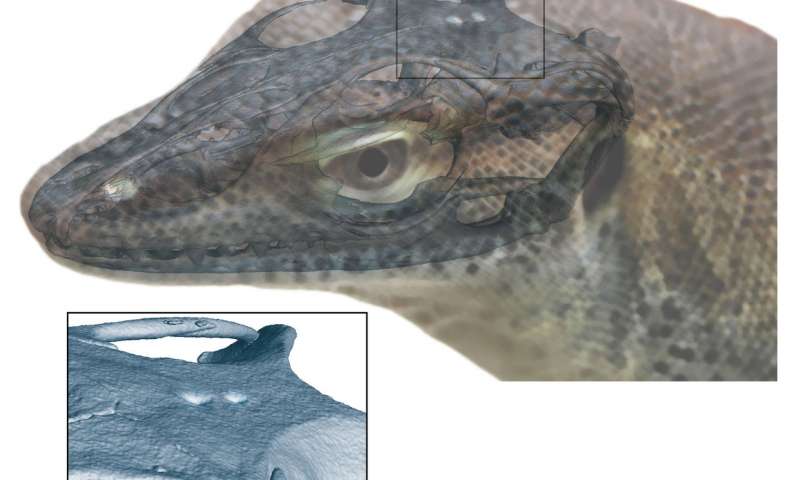Scientists were stunned by the discovery of a four-eyed ancient monitor lizard that went extinct around 34 million years ago. This is the first example of such a creature among jawed vertebrates. To this day, the only animal that we know of that has four eyes is the jawless lamprey.

The parietal and pineal foramina in the extinct monitor lizard are visible on the overlaid skull. Credit: Senckenberg Gesellschaft für Naturforschung / Andreas Lachmann.
It used to be common among primitive lower vertebrates to have a ‘third eye’, a socket in the skull known as the pineal organ. As with a regular eye, the pineal eye is made up of a cornea, a lens, and a retina. However, unlike conventional eyes that can discern sharp features, a pineal eye is far more limiting, being only able to detect changes in brightness. ‘Now it’s dark; now it’s sunny,’ the third-eye tells the creature. Many existing reptiles such as monitor lizards, some iguanas, and the tuatara still have a pineal eye.
Of course, a pair of eyeballs can also inform a creature whether’s it’s dark or light outside, so what’s the point of having an awesome third eye? Research shows that in reptiles, the pineal eye acts more as a calendar, sensing when days are growing shorter and nights longer, informing the brain of seasonal fluctuations. The third eye may also aid in orientation. Our early pre-mammalian ancestors all had a third-eye, researchers think, but over the course of evolutionary history, it has since been discarded with the pineal organ being incorporated in the endocrine system.

A monitor lizard skull fossil fragment where both the parietal and pineal foramina are visible (highlighted in yellow). Credit: Yale Peabody Museum of Natural History.
There’s also a fourth eye-like photosensory structure known as the parapineal organ, and today lampreys form eyes from both structures. But when researchers at the Senckenberg Research Institute in Germany analyzed two specimens of the ancient monitor lizard Saniwa ensiden, which were collected during the 19th century in Wyoming, they were amazed to find that this ancient creature had both pineal and parapineal organs.
The CT scans showed that the individuals had spaces where a fourth eye could have been seated. This suggests that third eye of lizards evolved independently from those in other vertebrate groups. In fact, other researchers are studying third eyes in fossils to come up with a better timeline for the split between ‘cold’ and ‘warm’ blooded of our pre-mammalian ancestors. That’s because all reptiles that still have the pineal eye today are ‘cold-blooded’ while modern mammals, which are all ‘warm-blooded’, lack a pineal eye. Using such an approach, South African researchers at the University of the Witwatersrand estimated that this transition occurred 246 million years ago.
Scientific reference: Current Biology, Smith et al.: “The Only Known Jawed Vertebrate with Four Eyes and the Bauplan of the Pineal Complex” http://www.cell.com/current-biology/fulltext/S0960-9822(18)30206-9 , DOI: 10.1016/j.cub.2018.02.021.









